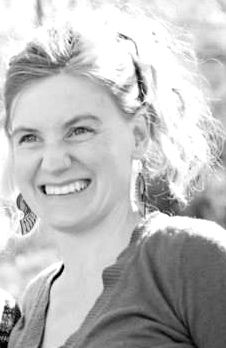
Aurah Landau
Here’s the latest installment in our series on the “Day in the Life” of nonprofit communicators, where we ask you to describe your day in your own words.
Aurah Landau is the part-time Communications Director at SERRC, which offers technical assistance to Alaskan school districts and job training/adult education in Southeast Alaska. She revels in applying the art of storytelling at work, across a bonfire with friends, and while snuggled up with her two-year-old son. Communication is connection, beauty and community to her.
Here is her typical day:
Before 8:00 am: Before 8 am, I’m peeking into the chicken coop for eggs, making scrambled eggs for breakfast, packing lunches, getting my toddler dressed (maybe the hardest part of my day!), and checking email to see if there are any burning issues that need resolution before I get to the office. Today, I see that a long monthly meeting is cancelled, and I’m happy to have the free time to dedicate to other work. I mentally reshuffle my day’s work agenda while pulling on my nylons.
After walking my toddler to preschool, I drive to work, skipping the coffee shop in order to get to my desk on time. I try to breathe deeply while I drive, and look at the beauty of the mountains and ocean around me so that I’m fresh for what’s next.
8:00 am – 10:00 am: I work three days a week, 6 hours a day, and am the only communications staffer for an education-service agency that covers the entire state of Alaska. I have to be strategic and efficient with my time, of course, and manage expectations well.
When I sit down at my desk, I make sure I have water and coffee…and a list of what I absolutely must accomplish. I usually have a separate list of what I’d like to get done but probably can’t. In short order, I respond to staff requests for info, rack up a few social media posts, and prepare for meetings. Today, I’ll also pitch a news story to our local newspaper, submit a PSA on job training we offer, write 6 grant support letters, schedule ad placements for the next 6 months, revise a webpage for one of our programs, mock-up a flier update, and review a powerpoint presentation for an upcoming conference.
10:00 am – 12:00 pm: I try to break around this time, to note what I’m procrastinating about and figure out why. Today, it’s a brochure somebody has requested, and I realize that I don’t see a clear program communications strategy underpinning the piece. I go back to basics with the program manager, talking through who we’re trying to reach, why and then mapping how. I start brainstorming hooks, message tweaking, writing text and collecting images. I call my graphic designer, and am grateful that she’s always willing to squeeze our projects into her schedule!
12:00 am – 2:00 pm: By now, I realize that I’ve forgotten to eat lunch and am losing focus. I wolf down the lunch I packed that morning, while checking my work email for anything urgent that’s popped up in the last few hours.
After lunch, I dig into longer-term projects. Right now, we are revamping our website and slowly moving from a branding / brochure-focused communications style to conversation / relationship-based style. All of that takes leadership refocus, staff training, new workflows, learning about our core audiences, clear definition of goals and strategies, and updated materials. So, I draft a survey for partners, revise a website structure outline with my Associate Director, and meet with my cross-agency Operations/Communications team to refine a staff training plan.
2:00 pm – 4:00 pm: This is my last chance in the day to keep little pieces of big projects moving. But, I need a refresher. I stretch my back, stroll to my mailbox, and nose into a blog post that intrigues me. I save the info for my resource library, and share it with staff whom I think can use it right now. Then, I’m back to writing copy for our website and reviewing the brochure version my graphic designer sent over. My last task of the day is to look at the social media posts I’ve scheduled, to see if I can make them more simple and catchy.
I try to leave the office at 3, but usually stop to talk to a few co-workers. I’m happy if I leave by 3:30, because that gives me time to have dinner ready before my toddler (who skipped his nap today, the stinker) gets too tired to function. Sometimes, I know how he feels!
When I’m home, I am religious about only checking my work email on my phone once at about 4:30 pm, to wrap up any loose ends that need attention before the end of the day. Today, I need to approve a camera-ready ad with the newspaper, reschedule two meetings, and share an AP story about a board member who won an award.
After 4:00 pm: After my son goes to bed and my husband is at the gym, I take a half hour to drink tea and brainstorm about things that have tripped me up during the day…a strained conversation with a co-worker, an outreach strategy that just isn’t coming together, that meeting I forgot to schedule, a better way to respond to my toddler’s sudden refusal to brush his teeth, and my wanting time to play hockey, start seeds for the garden, and ski with my husband. I take notes, but don’t turn my computer on. This musing time helps me stay organized, prioritize competing needs, and keep my eye on the big picture in both work and in work-home balance.
Sometimes, I end the day confidant that I’ve got a grip professionally and that I made focused time for my family. I almost always fall asleep with my clothes on.
(On the days that I’m not officially in the office, I check email 2-3 times per day to trouble-shoot. Usually I end up working about 45 minutes each day, mostly from my phone, to respond to critical needs.)
Want to be featured in this series? Tell us what you do in a typical day as a nonprofit communications pro.





